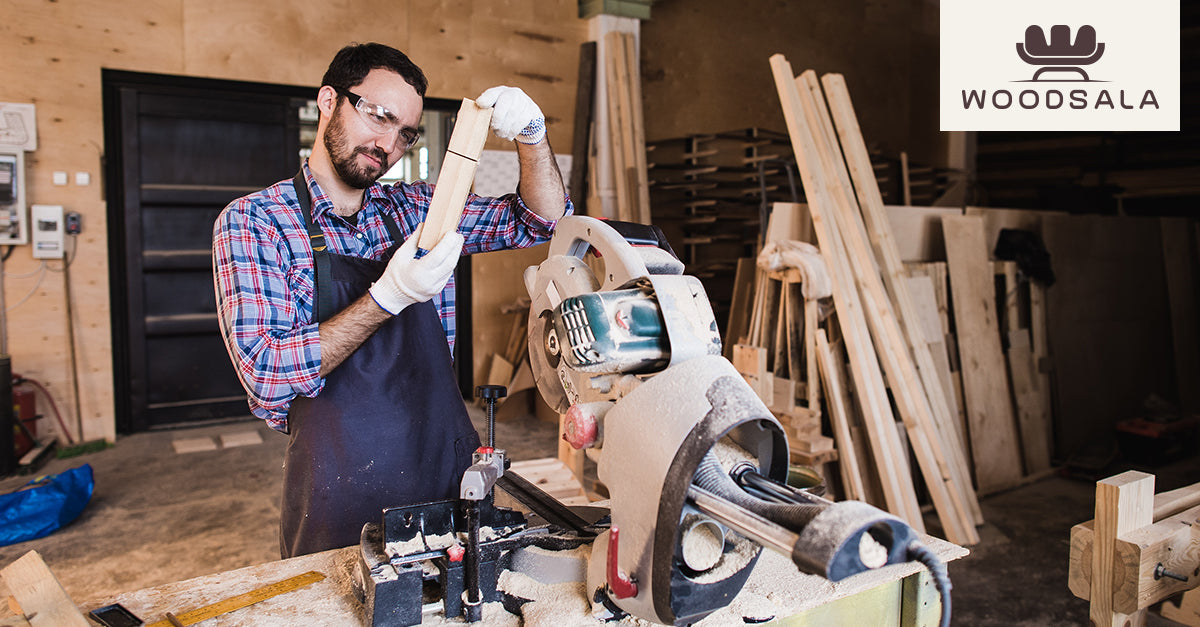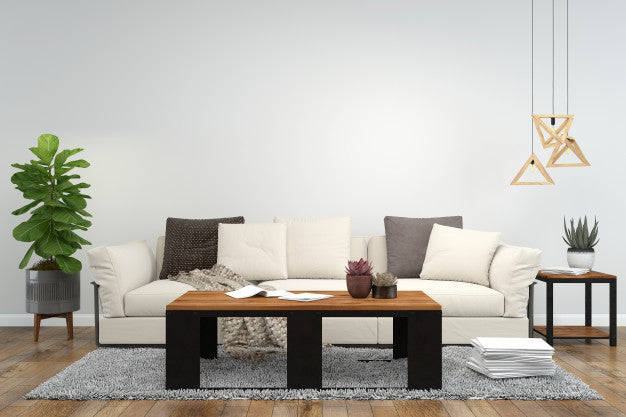
The Varying Worlds of Wood in Furniture
From couches to cabinets, beds to bookcases, there’s no functional area in the house that is untouched by the finesse and richness of wooden furniture. Its unique aesthetics, sturdy constitution, and glossy finishes are unmatched by other staple materials. Make an informed decision, and new pieces can transform the mood of a room—or your entire house—creating a homely, welcoming feel.

What are the advantages of using wood?
Wood has been used in furniture making for centuries, lending a timeless appeal to the most humble of creations. As you run your fingers along the fine grain of high-quality timbre, you might be reminded of these three qualities that help you make your pick:
- Strength and durability: If you’re looking for longevity in your home furniture, go for wood. The stability of well-built wooden furniture cannot be undermined. With a little buffing and care, it can retain its shine for unexpectedly long periods. Simple waxing and polishing do the trick. For furniture involved in daily use, do it at least once a year; parts facing indirect use can do with polishing every three to four years. If you have an eye for maintenance, the furniture can last years to come and fetch excellent resale value.
- Unmatched look and feel: Whether you pick hardwood, softwood or engineered wood, this staple in furniture-making adds an immediate touch of elegance to a room. The natural grain and myriad swirls and shades create an ambiance that is both artistic and comfortable. Employ a skilled woodworker or wooden furniture store to keep the finishes intact, and you have a family heirloom that can be passed down for generations.
- Sustainability: Aside from bamboo, wood is the only eco-friendly and sustainable material used in furniture making. While deforestation is a concern, wood can be a renewable material—the trees that are felled can be replenished by new growth, whether it be natural or human-assisted. The wooden furniture industry is also a source of livelihood for local artisan communities, empowering them to carry on age-old manufacturing and carving traditions, which strengthens local economies.
Now that we’ve understood what makes wood the backbone of the furniture industry, let’s break down how it’s commonly used:
Wooden Furniture Types
Two types of wood are primarily used to make furniture. The first is solid wood, which comes from timber and is the direct product of a tree. Ideal for weight-bearing furniture, it includes both hardwood and softwood. The second is manufactured wood. Also known as composite wood or mass timber, this is a derivative product engineered from real wood and synthetic materials—usually sawdust, chemicals, and glue.
Unless you have budget restrictions, it’s always advised to go for solid wood to create bespoke, long-lasting pieces for your home.
Hardwood comes from deciduous trees that shed their leaves every year. These trees grow slowly, which is why hardwood products tend to be on the expensive side. But at the same time, hardwood trees have biological properties that allow them to be fire-resistant. The timber is admirably dense and heavy and can withstand much wear and tear. A sleek and adaptable material for modern homes, these are a few popular choices for hardwood furniture:
Oak: A favourite for first-time buyers. A versatile hardwood, oak lends itself to various kinds of weight-bearing furniture across different room types—bed frames, side tables, bookshelves, chests of drawers—and even heirloom pieces like grandfather clocks. With colours ranging from light brown to pink-red, oak has a distinct swirling striped grain that both fits in and stands out in every room. Oak is also fairly affordable, offering durability without breaking the bank.
Maple: There’s more to it than syrup! Spread over 100 species, maple trees are found in Europe, North Africa, Asia, and North America. A smooth hardwood featuring decorative grain, maple wood is used to make products like bowling pins, billiards cues, or chopping blocks that suffer harsh use. The wood is also moisture-resistant, making use of furniture an obvious choice. While naturally coloured in shades of cream to reddish brown, softer species of maple can also take on painted finishes with ease. With this openness to ornamentation, maple wood is commonly used in wooden flooring, cabinetry and kitchen accessories.
Mahogany: One of the more expensive names, mahogany wood ranges in colour from medium brown to a deep reddish-brown. Seen as a ‘traditional’ wood, mahogany’s shine, rich colours and straight-grained texture push it towards classical uses like wooden furniture, panelling, boat construction, and the creation of musical instruments. Mahogany trees come in three speices, and can be quite large, making their boards broad and easier for woodworking. Of these three species, Honduran mahogany, found in the tropical forests of Central and South America, has the widest commercial use.
Walnut: With straight grains and a chocolate brown cast, walnut is a rare hardwood but carves well. This makes it a good choice for ornate furniture that requires intricate woodworking in the form of mantelpieces, headboards, banisters, and more. Prized in 17th and 18th century Europe, walnut was primarily used to construct cabinets—and some of them survive to this day. The tree is grown mainly in China, North America, Ukraine, Iran, and Turkey, plus India’s Himalayan belt. Since the wood is scarcely found, it’s one of the most expensive. Walnut veneers, thus, are a more common choice compared to constructing solid walnut furniture.
Ash: Ash is a tough hardwood that comes in a variety of grades. Inherently shock resistant, it is used in moulding and millwork for its ability to bend easily. Bent pieces of wooden furniture that require finishing, such as chairs with curved backrests, or door and cabinet handles, see the use of ash wood. Its colours range from a pale greyish yellow to dark brown, featuring a straight grain.
Birch: Found in the temperate and boreal regions of the Northern Hemisphere, birch is an affordable hardwood due to its abundance and uneven natural tones. It provides lumber that is harder than oak, and this durability allows birch wood to hold screws well, making it a favourite for benches, tables, and kitchen cabinets.
Cherry: This wood comes from the cherry fruit tree, and is slightly softer than maple. Nevertheless, it’s still a durable choice and is sought after for its pinkish brown and deep red hues that darken over time. Brittle and prone to dents when dry, cherry wood becomes pliable after steam bending. A sophisticated choice for home furniture, it’s also used to manufacture toys, caskets, panelling, and flooring.
Teak: A popular variety across continents and decades. Grown in plantations in Africa, Asia, and Latin America, teak was once readily available, but now has a limited supply due to controlled deforestation practices. It can withstand extreme heat and cold and has a high natural oil content, which wards off decay and insect attacks. This makes it perfectly suited for outdoor furniture on patios, terraces, and gardens.
Sal: Native to the Indian subcontinent, sal wood is water and termite-resistant, making it a popular choice for home construction. Usually light in colour, it darkens from exposure to sunlight. It also has a tough and coarse grain and does not accept finishes easily. You might not want to use it for furniture unless you’re going for a rustic, barebones look.
Rosewood: Belonging to the genus Dalbergia, Brazilian and East Indian rosewoods are primarily used in the making of luxury furniture and woodworking. Its fragrant wood, striking dark veining and bright auburn colour ooze class, but overexploitation has led to dwindling numbers and a high price tag. Its different species are now on the IUCN Red List of Threatened Species. Apart from furniture, rosewood is used to make chess sets, instruments like guitars and xylophones, panelling, and veneers.
Now that you’ve explored the most popular hardwood varities for wooden furniture, let’s look at softwood.
Softwood comes from evergreen, coniferous trees that do not produce seeds. Softer (you might’ve guessed) and lighter than hardwoods, their physical makeup is not as dense. Their use in furniture comes only under special cases.
Pine: Commonly used in bedroom sets, tables, and kids furniture, pine is prone to scratches and dents. Thus, it’s used to make the basic frame of a piece of furniture before being topped with a veneer of a high-quality wood. Light in colour, pine develops a fine patina with age.
Spruce: A lightweight variety with medium density, spruce furniture isn’t the most long-lasting, but you can prolong its durability with a coat of paint or other protective treatments. Easy to saw and machine through, spruce is used for industrial and building construction, low-stress decorative treatments for walls and ceilings, and the manufacture of instruments.
Cedar: Bearing a distinct aroma, cedarwood oil is extracted from this tree’s needles, berries, leaves, and bark for its medicinal properties. Naturally anti-bacterial and anti-fungal, cedarwood is insect-repellant and a popular choice for furniture aimed at long-term clothing storage, such as wardrobes, chests, and dressers. Since the wood is soft, it should not be used for making heavy furniture like dining tables and bed frames.
Fir: Known for its resistance to rot and pests, fir wood is used in constructing architectural support beams, multi-level structures and bridges, millwork, plywood manufacture, and the creation of windows and door frames. However, it is also recommended for making outdoor furniture such as deck chairs. Durable, with low shrinkage, it can be made waterproof with chemical treatment. In terms of visual appeal, fir wood is not easy to finish but has a close-grained pattern and natural lustre.
Larch: This wood is tougher than other conifers, and has a high resin content, which makes it waterproof. A particularly sturdy softwood, larch is used in construction beams, flooring, fence posts, and boat building. As far as furniture is concerned, it is good for exterior work such as decks, picnic tables, plant holders and walkways. It can withstand extreme climate, fungal and pest attacks, and is not affected by acids and alkali.
While this is not an exhaustive list, it’s a quick glance at the diverse wonders that wait in the world of wooden furniture. Each variety of wood—owing to its colour, grain, hardness, workability, and resistance to external factors—can lend itself to the creation of stellar furniture if you take your time to make the right choice. The next time you go furniture-hunting, keep our guide in mind to make the most of your visit!



























